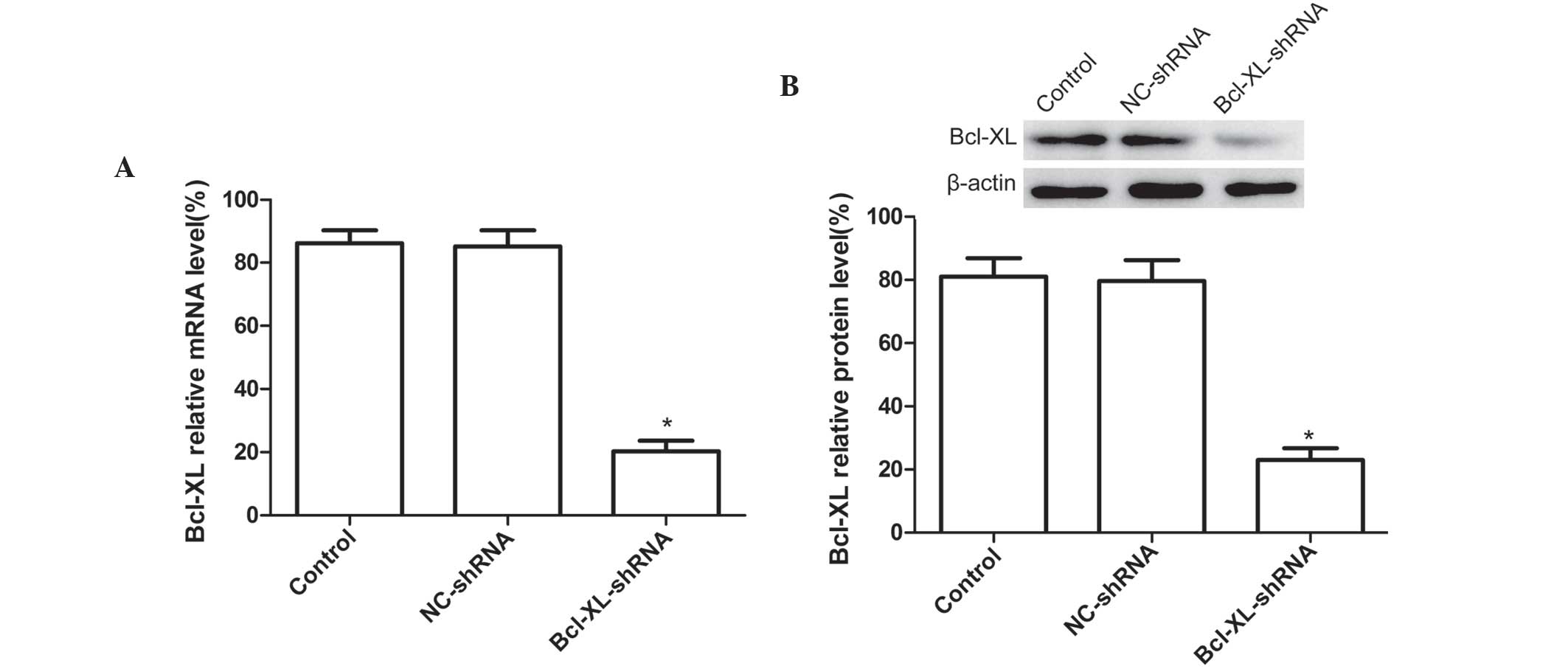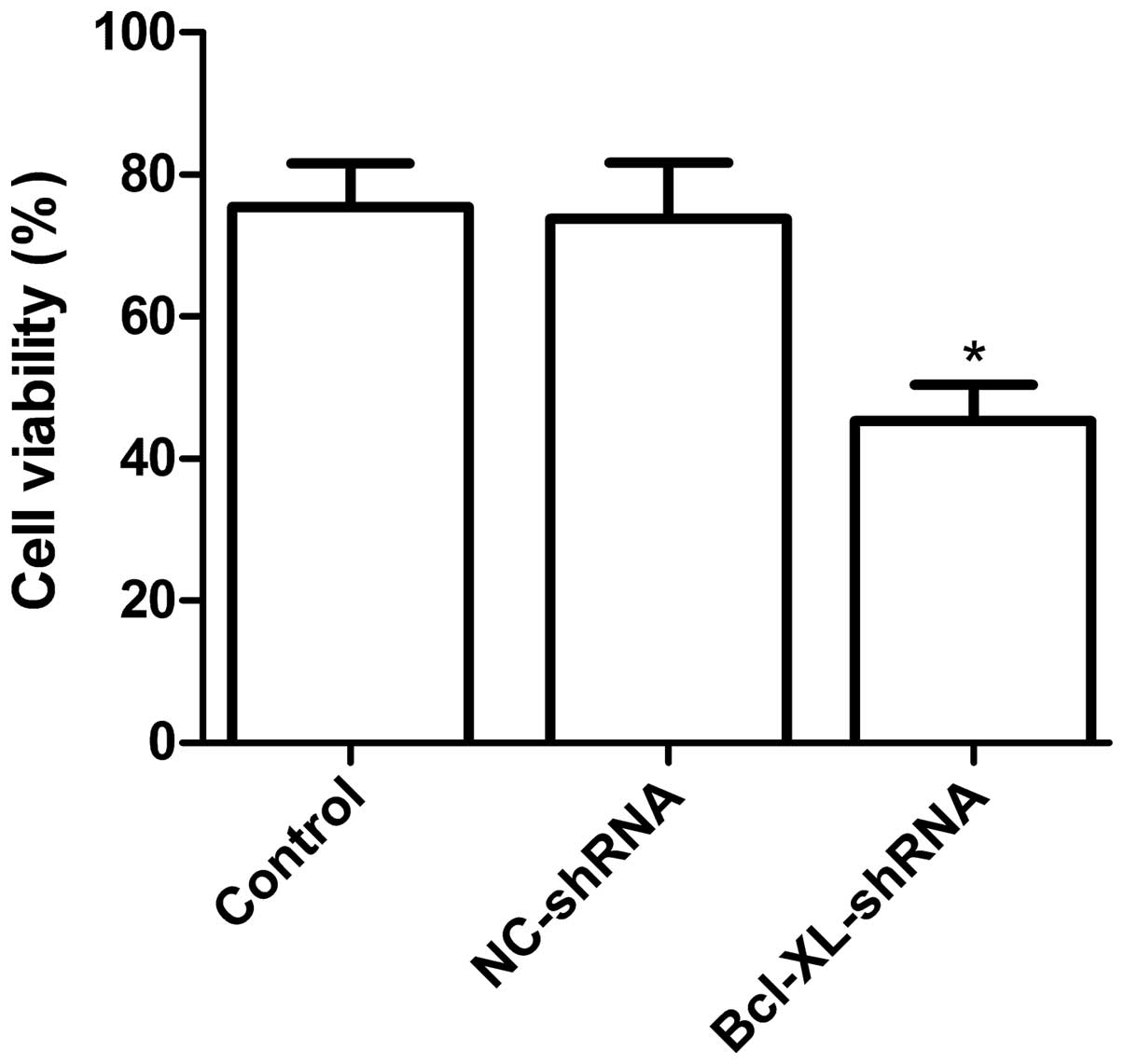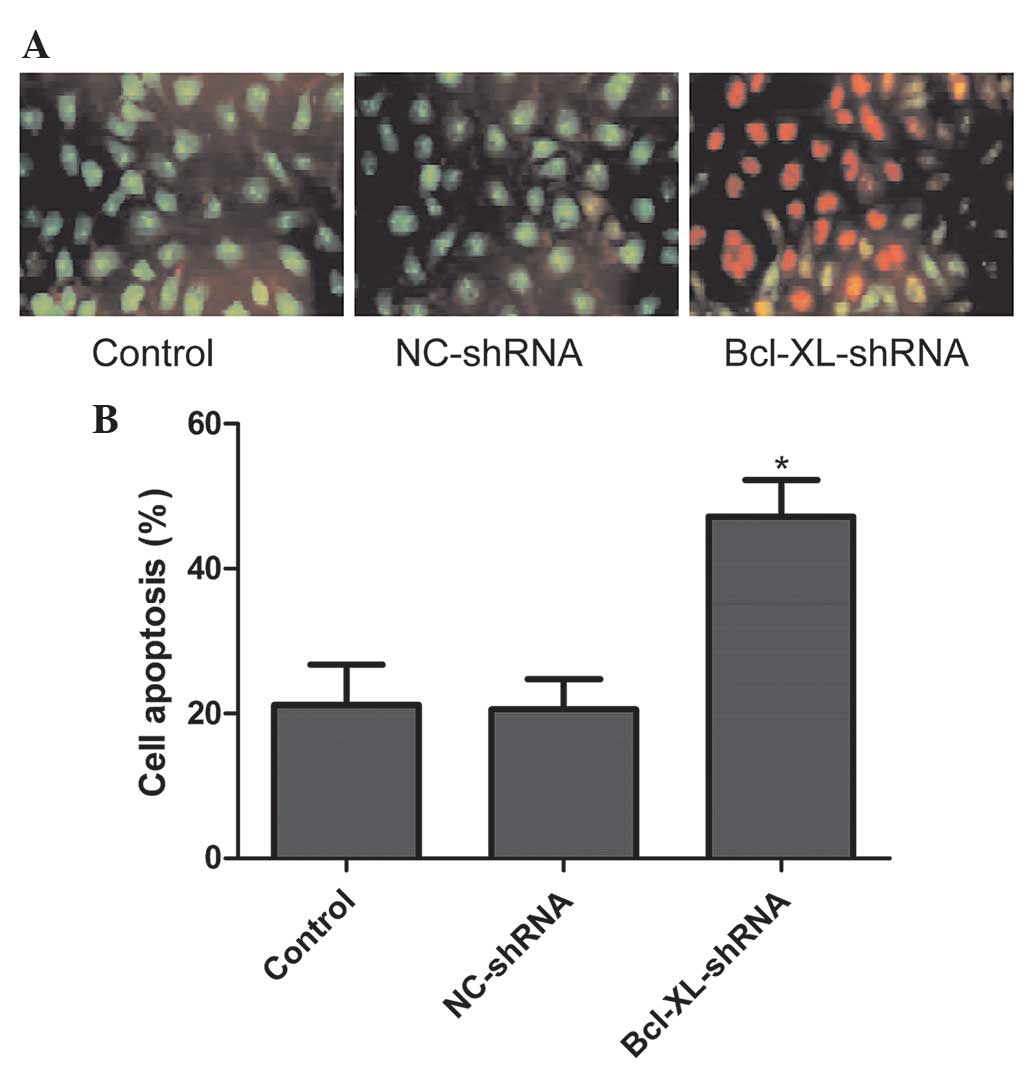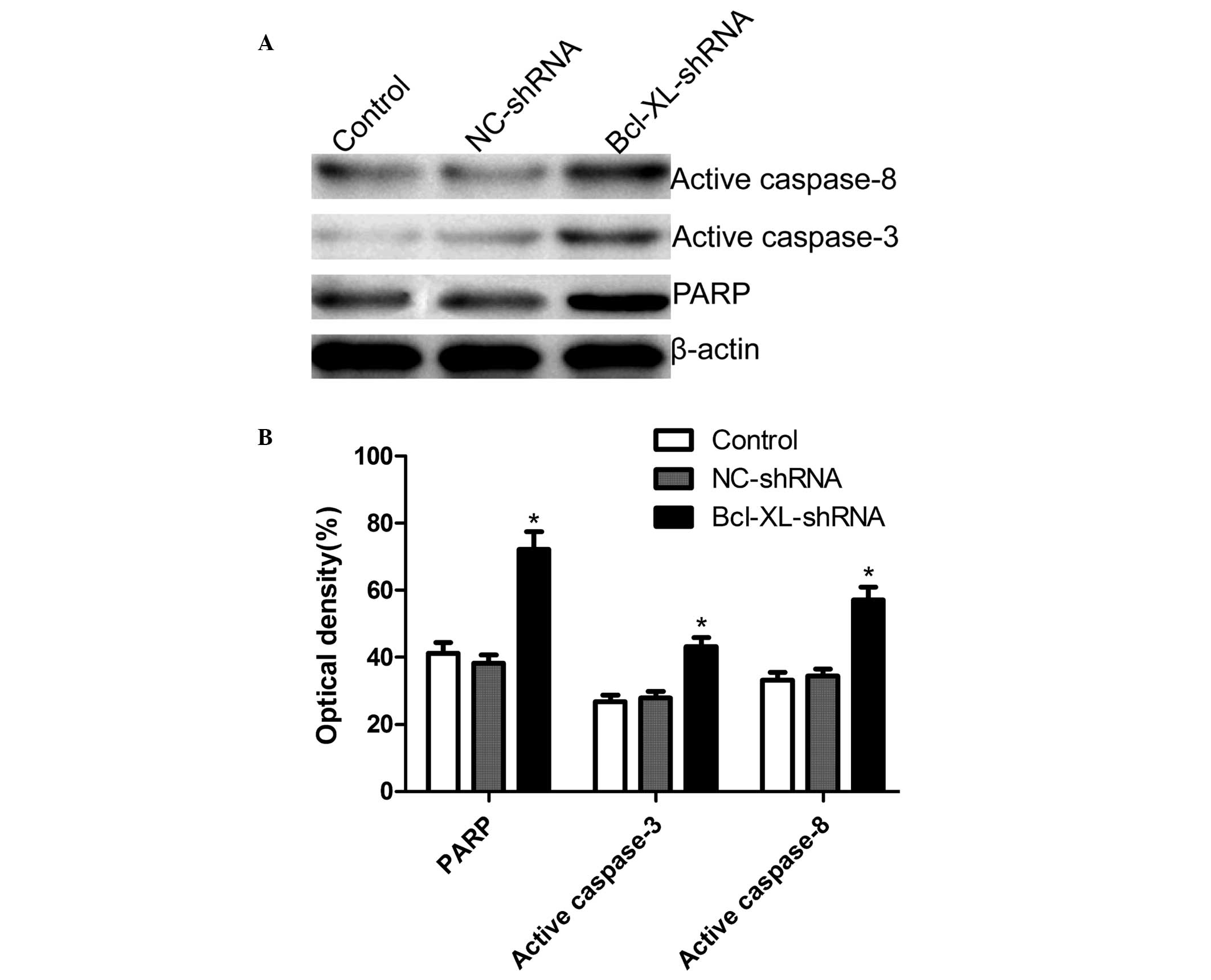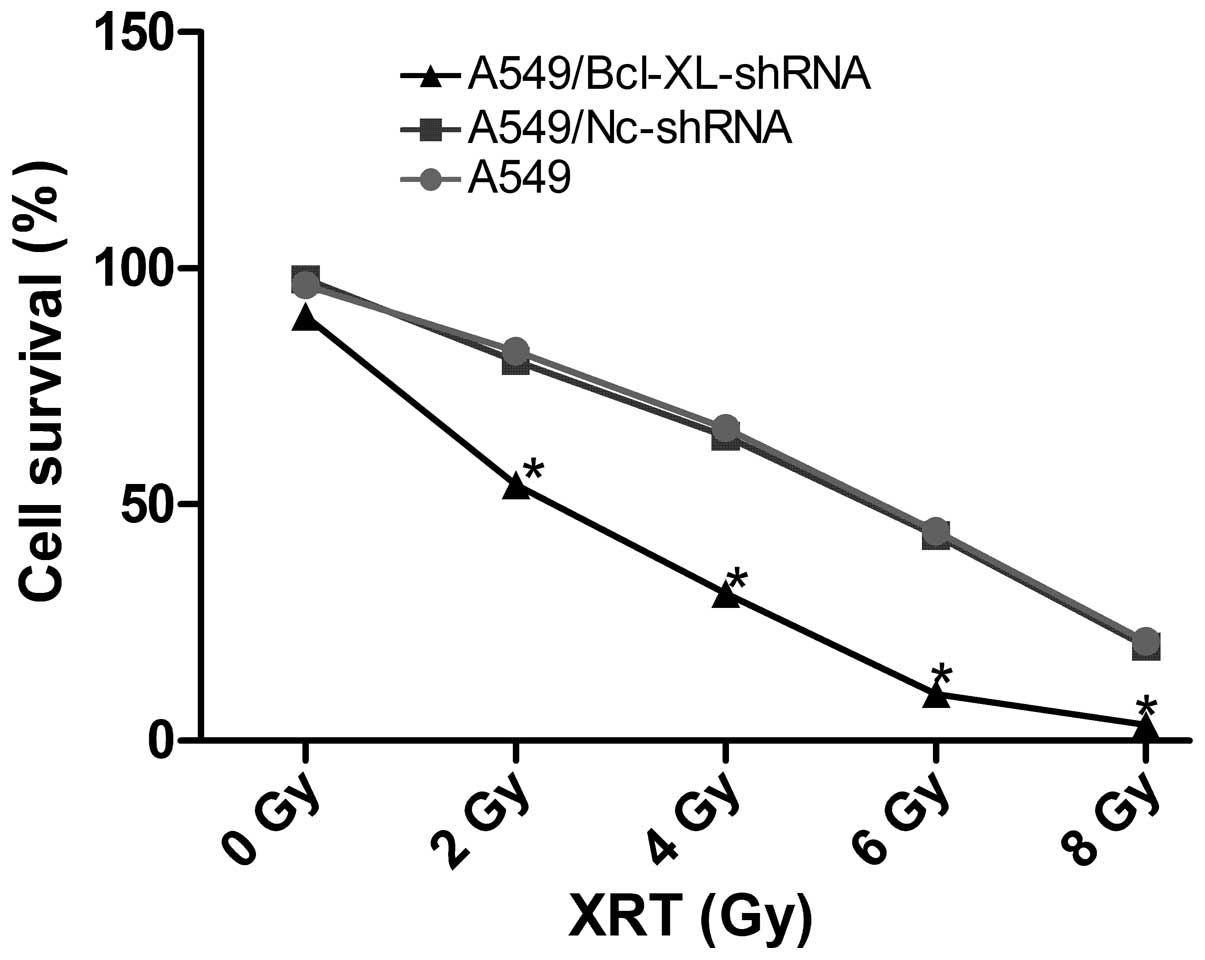Downregulation of the expression of B‑cell lymphoma‑extra large by RNA interference induces apoptosis and enhances the radiosensitivity of non‑small cell lung cancer cells
- Authors:
- Published online on: February 12, 2015 https://doi.org/10.3892/mmr.2015.3346
- Pages: 449-455
Abstract
Introduction
Lung cancer is the most common cause of cancer-associated mortality and its morbidity is increasing worldwide, and ~85–90% of lung cancer cases are non-small cell lung cancer (NSCLC) (1). Surgery, chemotherapy and radiation are the three major therapeutic approaches for the treatment of lung cancer. Radiotherapy is commonly used for the treatment of NSCLC, and >50% of newly diagnosed patients with lung cancer worldwide receive radiotherapy, either alone or in combination with surgery or chemotherapy, during their treatment (2). However, the rates of complete recovery are low and long-term survival rates remain poor, since the curative potential of radiotherapy is often limited due to intrinsic radio-resistance of cancer cells and systemic dose-limiting toxicity to normal tissues (3–6). Therefore, there is increasing interest in enhancing the radiosensitivity of lung cancer cells for the development of more effective and less toxic treatments.
Proteins of the B-cell lymphoma (Bcl)-2 family have been identified as key regulators of apoptosis (7). The Bcl-2 family of proteins is comprised of anti-apoptotic proteins, including Bcl-2, Bcl-extra large (xL) and myeloid leukemia cell differentiation protein; pro-apoptotic proteins, including Bcl-2-associated X protein (Bax); and Bcl-2-antagonist/killer and Bcl-2 homology domain 3-only proteins, including Bim, Bcl-2-associated death promoter (Bad), Phorbol-12-myristate-13-acetate-induced protein 1, p53 upregulated modulator of apoptosis and hara-kiri (8). The overexpression of anti-apoptotic Bcl-2 family proteins contributes to the development of cancer and to cancer cell resistance against a wide variety of anticancer agents (9–11). Bcl-xL, a major member of the anti-apoptotic Bcl-2 family, is overexpressed in NSCLC (12,13). The over-expression of Bcl-xL has been observed to counteract the pro-apoptotic functions of Bax and Bad by preventing their translocation between the cytosol and the mitochondria (14). Several studies have revealed that inhibiting the expression of Bcl-xL, using antisense oligonucleotides or small interfering (si)RNA, suppresses the proliferation of and sensitizes tumor cells to chemotherapeutic agents (15–17). Varin et al demonstrated that knockdown of Bcl-xL using siRNA sensitizes two highly chemoresistant mesothelioma cell lines to treatment with cisplatin (18). Guichard et al found that short hairpin (sh) RNAs targeting Bcl-xL modulated senescence and apoptosis following exposure to SN-38 and irinotecan in a model of colon cancer (15). Lei et al demonstrated that Bcl-xL siRNA contributed to an increase in diamminedichloroplatinum (DDP)-induced cell death in NSCLC and sensitized cells to DDP, leading to an increase the effectiveness of the drug in treating NSCLC (19). Notably, a previous study revealed that downregulation of Bcl-xL using siRNA increased the in vitro and in vivo radiosensitivity of colorectal cancer cells by increasing caspase-dependent apoptosis (20). These studies suggest that the protein expression of Bcl-xL is critical for tumor development, progression and resistance to therapy, including chemotherapy and radiation. However, whether the inhibition of Bcl-xL is an effective approach to overcome the radioresistance exhibited by NSCLC remains to be elucidated. The present study aimed to examine Bcl-xL as a therapeutic target for the treatment of human NSCLC.
The successful use of siRNA in downregulating gene expression in a number of model systems has led to several attempts to examine this methodology as a potentially therapeutic approach (21). DNA vector-based shRNA technology can achieve persistent silencing of endogenous gene expression (22). In the present study, the expression of Bcl-xL was downregulated using RNA interference (RNAi) to investigate the role of Bcl-xL in radioresistance, and to determine the feasibility and efficacy of combination therapy, involving siRNA targeting Bcl-xL and radiotherapy, on NSCLC cells.
Materials and methods
shRNA design and plasmid construction
The cDNA sequence of Bcl-xL was obtained from GenBank (accession no. Z23115). Bcl-xL-shRNA was designed using siRNA target design finder (Ambion Inc., Austin, TX, USA) and the sequences were as follows: Bcl-xL-shRNA, sense 5′-CAGGGACAGCATATCAGAG-3′ and antisense 5′-GTCCCTGTCGTATAGTCTC-3′. The oligo-nucleotides were annealed and inserted into the BamHI and HindIII sites on the pSilencer4.1-CMVneo vector (Ambion Inc.), according to the manufacturer’s instructions (Ambion Inc.). The pSilencer4.1-CMVneo vector contains the SV40 early promoter to provide G418 resistance in mammalian cells. The recombinant vectors were confirmed by digestion analysis using restriction endonucleases BamHI and HindIII (Takara Bio, Inc., Dalian, China) at 37°C for 2 h and the inserted sequences were verified by DNA sequencing. A negative control vector, expressing a hairpin siRNA with limited homology to any known sequences of the human genome, was commercially available (Ambion Inc.). The shRNA vector containing the oligonucleotides encoding Bcl-xL was termed Bcl-xL-shRNA and the negative control (NC) vector was termed NC-shRNA. The purified DNA was diluted to 1 mg/ml and stored at -20°C until use.
Cell culture and transfection
The A549 human NSCLC cell line was purchased from Cell Bank of Type Culture Collection of Chinese Academy of Sciences (Shanghai, China). The A549 cells were cultured in RPMI-1640 medium (Invitrogen Life Technologies, Carlsbad, CA, USA) supplemented with heat-inactivated 10% fetal bovine serum (Biochrom AG, Berlin, Germany), 100 U/ml penicillin and 100 mg/ml streptomycin (Sigma-Aldrich, St. Louis, MO, USA) at 37°C in a humidified atmosphere containing 5% CO2.
The A549 cells were then seeded into 6-well plates at a density of 2×104 cells/well and cultured overnight to 80–90% confluence prior to transfection. Transfection was performed using Lipofectamine Plus (Invitrogen Life Technologies), and the ratio of the plasmids to transfection reagent was 1 mg:2 ml. The cells were transfected with either the Bcl-xL-shRNA or NC-shRNA plasmids, according to the manufacturer’s instructions. G418 (800 μg/ml; Sigma-Aldrich) was used to screen for stably transfected clones. The stable transfectants were termed A549/Bcl-xL-shRNA and A549/NC-shRNA.
Reverse transcription-quantitative polymerase chain reaction (RT-qPCR)
The transfected and non-tranfected cells were collected and washed with phosphate-buffered saline (PBS; Sigma-Aldrich). The total RNA was extracted from the cells using TRIzol reagent (Invitrogen Life Technologies), according to the manufacturer’s instructions. Moloney Murine Leukemia Virus reverse transcriptase (Fermentas, Waltham, MA, USA) was used to amplify the cDNA, according to the manufacturer’s instructions. The RT-qPCR assays were performed using SYBR TAQ real-time kits (Takara Bio, Inc., Otsu, Japan) and RT-PCR amplification equipment (ABI PRISM 7900HT; Applied Biosystems, Foster City, CA, USA). The primer sequences used for qPCR were as follows: Bcl-xL, sense 5′-CGTGGAAAGCGTAGACAAGGA-3′ and antisense 5′-ATTCAGGTAAGTGGCCATCCAA-3′ and GAPDH, sense 5′-TGTGGGCATCAATGGATTTGG-3′ and antisense 5′-ACACCATGTATTCCGGGTCAAT-3′. The PCR conditions were as follows: Predenaturation at 94°C for 5 min, followed by 40 cycles of denaturation at 94°C for 10 sec, annealing/extension at 60°C for 15 sec and final extension at 72°C for 10 min. The specificity of the amplification was confirmed using melting curve analysis. The expression of target genes were normalized against the expression of GAPDH. The fold-change was calculated, as described previously (23), and the data are presented as the fold-change in expression relative to the untransfected controls.
Western blotting
The cells were homogenized in lysis buffer (Sigma-Aldrich) containing 50 mmol/l Tris-HCl, 5 mmol/l EDTA, 150 mmol/l NaCl, 1% sodium deoxycholate, 500 μmol/l Na3VO4, 0.5% Triton X-100, 10 μmol/l 4-(2-amino-ethyl) benzenesulfonyl fluoride hydrochloride (AEBSF) and 10 mmol/l NaF, on ice for 30 min. The homogenates were subsequently centrifuged at 12,000 × g at 4°C for 15 min, the supernatants, containing the total cellular protein, were collected and the protein concentration was determined using a Bicinchoninic Acid Assay kit (Sigma-Aldrich). Equal quantities of protein lysate (50 μg) were electrophoretically separated on 10 or 8% sodium dodecyl sulfatepolyacrylamide gels, transferred onto polyvinylidene difluoride membranes (Millipore, Bedford, MA, USA) and were blocked in 3% bovine serum albumin for 2 h. Following blocking, the membranes were incubated with the following antibodies: Mouse anti-Bcl-xL monoclonal antibody (1:1,500; sc-271121), mouse anti-caspase-3 polyclonal antibody (1:2,000; sc-7272) and mouse anti-caspase-8 polyclonal antibody (1:3,000; sc-56070), which were all purchased from Santa Cruz Biotechnology, Inc (Santa Cruz, CA, USA), as well as mouse anti-poly(ADP-ribose) polymerase (PARP) polyclonal antibody (1:1,000; #9544; Cell Signaling Technology, Inc., Beverly, MA, USA) and mouse monoclonal anti-β-actin (1:5,000; A2228; Sigma-Aldrich), overnight at 4°C. The membranes were subsequently incubated for 2 h at 37°C with horseradish peroxidase-conjugated anti-mouse secondary antibody (Santa Cruz Biotechnology, Inc.). β-actin was used as a loading control. The bound antibodies were detected using an enhanced chemilluminescence kit (Santa Cruz Biotechnology, Inc.). Densitometric analysis was performed using Quantity One image analysis software (Bio-Rad Laboratories, Hercules, CA, USA).
Cell proliferation assay
The cell viabilities of the untransfected, stably transfected A549/Bcl-xL-shRNA and A549/NC-shRNA A549 cells were measured using a 3-(4, 5-dimethylthazol-2-yl)-2, 5- diphenyl tetrazolium bromide (MTT) assay (Sigma-Aldrich). Briefly, the A549 cells were seeded into seven 96-well plates at a density of 4×103 cells/well, with eight wells per group/subgroup. Following 48 h culture, 200 μl MTT (5 mg/ml) was added to each well, followed by incubation at 37°C for 4 h. The supernatant was then removed and 200 μl dimethyl sulfoxide was added to each well, followed by agitation for 10 min. The optical densities were determined using a Versamax microplate reader (Molecular Devices, LLC., Sunnyvale, CA, USA) at 490 nm, and the growth inhibition was calculated as follows: Inhibition rate (%)=[1-(average absorbance of experimental group/average absorbance of blank control group)]×100%.
Analysis of apoptosis
Cell apoptosis was identified by fluorescence staining using acridine orange (AO) and ethidium bromide (EB) from Molecular Probes (Eugene, OR, USA). For the morphological examination of apoptosis, the untransfected, stably transfected A549/Bcl-xL-shRNA and A549/NC-shRNA A549 cells (5×103/well) were seeded into a separate 24-well microplate for 48 h, washed three times with PBS and mixed with an identical volume of dual AO/EB solution (100 μg/ml). The final volume (200 μl) was observed using a CKX41 fluorescence microscope at ×20 magnification (Olympus, Tokyo, Japan). For quantification, five random fields were selected and at least 300 cells were quantified in each field. All experiments were performed in triplicate. At the molecular level, the protein expression levels of PARP, caspase-3 and caspase-8 were assessed by western blotting, as described above, an additional indicator of apoptosis.
Clonogenic cell survival assay
The untransfected or stably transfected A549/Bcl-xL-shRNA and A549/NC-shRNA A549 cells were seeded seperately at a density of 5×103 cells/well into each well of 96-well plates in triplicate. Following culture for 72 h, the cells were trypsinized and cells (1×104/well) were seeded into six-well plates and allowed to attach for 6 h at 37°C in a humidified atmosphere containing 5% CO2. The cells were then irradiated with different doses (0, 2, 4, 6, and 8 Gy) of 6 MV X-ray radiation using a 23EX accelerator (Varian Medical Systems,. Inc., Palo Alto, CA, USA) at room temperature, and were subsequently incubated for 14 days. The colonies were stained with crystal violet and the number of colonies containing >50 cells were quantified. The plating efficiency was calculated as follows: Plating efficiency (%) = (colony number / total cells seeded) × 100%. All experiments were performed in triplicate. The cell survival fraction was determined and a cell survival curve was produced.
Statistical analysis
All experiments were performed in triplicate as independent experiments. The data are expressed as the mean ± standard deviation. Comparisons between two samples were calculated using Student’s t-test and comparisons of >2 groups were calculated using one-way analysis of variance followed by a Tukey’s post hoc test using Graphpad Prism 6.0 software (San Diego, CA, USA). P<0.05 was considered to indicate a statistically significant difference.
Results
Specific downregulation of the expression of Bcl-xL by Bcl-xL-shRNA
The mRNA and protein expression levels of Bcl-xL in the NSCLC cells were analyzed by RT-qPCR and western blotting. As shown in Fig. 1A, the mRNA expression of Bcl-xL in the Bcl-xL-shRNA group was significantly decreased compared with the untransfected control group and the NC-shRNA group (P<0.05). No significant difference was observed between the NC-shRNA group and the control group. Additionally, the protein expression level was significantly reduced in the Bcl-xL-shRNA group compared with the control and NC-shRNA groups (P<0.05; Fig. 1B). No significant change in the protein expression levels of Bcl-xL was observed between the NC-shRNA group and control group (P>0.05). These results demonstrated that the expression levels of Bcl-xL in the A549 cells were downregulated, specifically and effectively, by Bcl-xL-shRNA.
Effect of Bcl-xL-shRNA on A549 cell proliferation
Using Bcl-xL-shRNA, the effects of downregulation of Bcl-xL on tumor cell proliferation were examined in vitro using an MTT assay (Fig. 2). The results demonstrated that transfection of the A549 cells with Bcl-xL-shRNA significantly inhibited cell proliferation compared with the control and NC-shRNA groups (P<0.01).
Effect of XIAP-shRNA on the apoptosis of A549 cells
To further investigate the effect of the shRNA-mediated down-regulation of XIAP, on cell apoptosis in the A549 cells the, A549/Bcl-xL-shRNA and A549/NC-shRNA stably transfected cells were collected and stained with AO/EB. The results demonstrated that cells transfected with Bcl-xL siRNA underwent typical apoptotic morphological changes of nuclear and cytoplasmic condensation, loss of cell volume and nuclear fragmentation. By contrast, the untransfected and NC-shRNA transfected cells exhibited no apoptotic characteristics (Fig. 3A). Statistical analysis revealed that the A549 cells transfected with Bcl-xL-shRNA significantly induced cell apoptosis compared with the untransfected and the NC-shRNA cells (P<0.01; Fig. 3B). Therefore, Bcl-xL-shRNA significantly accelerated the apoptosis of A549 cells.
Preliminary mechanisms underlying Bcl-xL-regulated cell apoptosis
To examine the mechanism underlying the induction of cell apoptosis, the expression levels of PARP, caspase-3 and caspase-8 in the A549 cells were determined by western blotting, following treatment with Bcl-xL-shRNA or NC-shRNA. As shown in Fig. 4, the expression levels of caspase-3, caspase-8 and PARP were markedly increased in the cells transfected with Bcl-xL-shRNA compared with those in the untransfected and the NC-shRNA-transfected cells.
Effect of Bcl-xL-shRNA on the radiosensitivity of A549 cells
To investigate the effect of Bcl-xL-shRNA on the radiosensitivity of A549 cells, clonogenic cell survival assays were performed. As shown in Table I, the plating efficiencies of the A549 cells transfected with Bcl-xL-shRNA cells at the same dose of radiation were significantly decreased compared with the control cells and the cells transfected with NC-shRNA (P<0.05). The cell survival curve revealed a marked decreased in the survival of the cells in the Bcl-xL-shRNA group compared with that observed in the untransfected A549 cells and the NC-shRNA group (P<0.05; Fig. 5). No significant difference was observed in the radiosensitivity of the untransfected cells and NC-shRNA cells. These results demonstrated that downregulatiion in the expression of Bcl-xL led to enhanced radiosensitivity in the NSCLC cells.
Discussion
NSCLC patients with non-resectable stage III or medically inoperable disease account for ~40% of all patients diagnosed with NSCLC (24). Radiation therapy is important in achieving local control of the tumor and in the relief of symptoms resulting from metastatic disease, therefore, radiotherapy is important in the management of NSCLC (25). However, partial lung cancer cell resistance to radiotherapy affects the therapeutic effects, and the 5-year survival rate of patients receiving radiotherapy alone is 5–10% (26). Local recurrence occurs in 80% of patients and metastasis occurs in 60% of patients (27), therefore, overcoming the resistance of NSCLC to radiotherapy remains a major challenge and requires further investigation to identify an effective radiosensitizer, which enhances tumor radiosensitivity with minimal negative effects on normal tissues.
The Bcl-2 family comprises a group of structurally associated proteins, which are fundamental in the regulation of the intrinsic pathway by controlling mitochondrial membrane permeability and the release of the the pro-apoptotic factor, cytochrome c (28). Therefore, the Bcl-2 family are key regulators of apoptosis and are important in regulating cell apoptosis (7). Bcl-xL is an important member of the anti-apoptotic Bcl-2 family, which has been reported to be important in tumor progression, development and chemoresistance (15–19). Several studies have demonstrated that Bcl-xL is involved in tumor apoptosis and is important in radioresistance in several types of tumor (20,29–31). Yang et al demonstrated that the downregulation of Bcl-xL by adenovirus-mediated shRNA increases the in vitro and in vivo radiosensitivity of colorectal cancer cells by increasing caspase-dependent apoptosis (20). Streffer et al revealed that the Bcl-xL and BAX proteins modulate radiosensitivity in human glioma cells, and that targeting alterations in Bcl-2 family proteins, including the expression of Bcl-2, may be a promising therapeutic approach to improve the efficacy of radiotherapy for gliomas (29). Masui et al demonstrated that the antisense oligonucleotide against Bcl-xL inhibits cell proliferation and increases the radiosensitivity of pancreatic cancer (30). Wang et al revealed that downregulation of Bcl-xL by siRNA increases the sensitivity of prostate cancer cells to radiation (31). However, there are no reports, to the best of our knowledge, on the association between the expression of Bcl-xL and radiosensitivity of human NSCLC cells. The present study examined changes in the radiosensitivity of A549 cells with downregulated expression of Bcl-xL using clonogenic survival assays. The results revealed that downregulation of the expression of Bcl-xL increased cell radiosensitization, which was consistent with previous studies (20,29–31).
Caspases are important in apoptosis triggered by various pro-apoptotic signals (32). A previous study demonstrated that Bcl-xL siRNA triggers a decrease in the protein expression of Bcl-xL and the activation of procaspase-3, followed by the cleavage of PARP, in lung cancer (19). In addition, Yang et al reported that silencing of Bcl-xL increases the activities of caspase-3 and caspase-8 in colorectal cancer cells (20). Consistent with this study, the present study demonstrated that downregulation Bcl-xL using shRNA activated PARP, caspase-3 and caspase-8 and induced cell apoptosis in the NSCLC cells. These results suggested that the downregulation of Bcl-xL induced apoptosis in the tumor cells by increasing caspase activity.
RNAi using double stranded siRNA molecules of ~20–25 nucleotides is a powerful method for preventing the expression of a particular gene, with high efficiency, high specificity and low toxicity (33). This technology is widely used to investigate gene function, cancer and viral disease therapy (33,34). To examine the possibility of Bcl-xL as an effective therapeutic target, the present study used an RNAi method to silence the endogenous expression of Bcl-xL in the A549 NSCLC cell line and analyzed the phenotypic changes in the stable transfectants. Stable downregulation in the expression of Bcl-xL by DNA vector-based shRNA was observed in the A549 cells, which inhibited proliferation, induced apoptosis and reduced the radioresistancse of the NSCLC cells. These results suggested that Bcl-xL may be a potential therapeutic target for the treatment of human NSCLC.
Acknowledgments
This study was supported by the Science and Technology Research and Innovation Team, funded by Jilin province (no. JL2011538).
References
|
Jemal A, Bray F, Center MM, Ferlay J, Ward E and Forman D: Global cancer statistics. CA Cancer J Clin. 61:69–90. 2011. View Article : Google Scholar : PubMed/NCBI | |
|
Nygren P and Glimelius B; SBU-group: Swedish Council on Technology Assessment in Health Care: The Swedish Council on Technology Assessment in Health Care (SBU) report on Cancer Chemotherapy - Project objectives, the working process, key definitions and general aspects on cancer trial methodology and interpretation. Acta Oncol. 40:155–165. 2001. View Article : Google Scholar | |
|
Impicciatore G, Sancilio S, Miscia S and Di Pietro R: Nutlins and ionizing radiation in cancer therapy. Curr Pharm Des. 16:1427–1442. 2010. View Article : Google Scholar : PubMed/NCBI | |
|
Zhang S, Wang L, Liu H, Zhao G and Ming L: Enhancement of recombinant myricetin on the radiosensitivity of lung cancer A549 and H1299 cells. Diagn Pathol. 9:682014. View Article : Google Scholar : PubMed/NCBI | |
|
Dumont F, Altmeyer A and Bischoff P: Radiosensitising agents for the radiotherapy of cancer: novel molecularly targeted approaches. Expert Opin Ther Pat. 19:775–799. 2009. View Article : Google Scholar : PubMed/NCBI | |
|
Bischoff P, Altmeyer A and Dumont F: Radiosensitising agents for the radiotherapy of cancer: advances in traditional and hypoxia targeted radiosensitisers. Expert Opin Ther Pat. 19:643–662. 2009. View Article : Google Scholar : PubMed/NCBI | |
|
Adams JM and Cory S: The Bcl-2 protein family: arbiters of cell survival. Science. 281:1322–1326. 1998. View Article : Google Scholar : PubMed/NCBI | |
|
Walensky LD: BCL-2 in the crosshairs: tipping the balance of life and death. Cell Death Differ. 13:1339–1350. 2006. View Article : Google Scholar : PubMed/NCBI | |
|
Yang TM, Barbone D, Fennell DA and Broaddus VC: Bcl-2 family proteins contribute to apoptotic resistance in lung cancer multi-cellular spheroids. Am J Respir Cell Mol Biol. 41:14–23. 2009. View Article : Google Scholar : | |
|
Yip KW and Reed JC: Bcl-2 family proteins and cancer. Oncogene. 27:6398–6406. 2008. View Article : Google Scholar : PubMed/NCBI | |
|
Kirkin V, Joos S and Zörnig M: The role of Bcl-2 family members in tumorigenesis. Biochim Biophys Acta. 1644:229–249. 2004. View Article : Google Scholar : PubMed/NCBI | |
|
Soini Y, Kinnula V, Kaarteenaho-Wiik R, Kurttila E, Linnainmaa K and Pääkko P: Apoptosis and expression of apoptosis regulating proteins bcl-2, mcl-1, bcl-X, and bax in malignant mesothelioma. Clin Cancer Res. 5:3508–3515. 1999.PubMed/NCBI | |
|
Karczmarek-Borowska B, Filip A, Wojcierowski J, et al: Estimation of prognostic value of Bcl-xL gene expression in non-small cell lung cancer. Lung Cancer. 51:61–69. 2006. View Article : Google Scholar | |
|
Gottlieb E, Vander Heiden MG and Thompson CB: Bcl-x(L) prevents the initial decrease in mitochondrial membrane potential and subsequent reactive oxygen species production during tumor necrosis factor alpha-induced apoptosis. Mol Cell Biol. 20:5680–5689. 2000. View Article : Google Scholar : PubMed/NCBI | |
|
Guichard SM, Hua ML, Kang P, Macpherson JS and Jodrell DI: Short hairpin RNAs targeting Bcl-xL modulate senescence and apoptosis following SN-38 and irinotecan exposure in a colon cancer model. Cancer Chemother Pharmacol. 60:651–660. 2007. View Article : Google Scholar : PubMed/NCBI | |
|
Zhu H, Guo W, Zhang L, et al: Bcl-xL small interfering RNA suppresses the proliferation of 5-fluorouracil-resistant human colon cancer cells. Mol Cancer Ther. 4:451–456. 2005.PubMed/NCBI | |
|
Nita ME, Ono-Nita SK, Tsuno N, et al: Bcl-X(L) antisense sensitizes human colon cancer cell line to 5-fluorouracil. Jpn J Cancer Res. 91:825–832. 2000. View Article : Google Scholar : PubMed/NCBI | |
|
Varin E, Denoyelle C, Brotin E, et al: Downregulation of Bcl-xL and Mcl-1 is sufficient to induce cell death in mesothelioma cells highly refractory to conventional chemotherapy. Carcinogenesis. 31:984–993. 2010. View Article : Google Scholar : PubMed/NCBI | |
|
Lei X, Huang Z, Zhong M, Zhu B, Tang S and Liao D: Bcl-xL small interfering RNA sensitizes cisplatin-resistant human lung adenocarcinoma cells. Acta Biochim Biophys Sin (Shanghai). 39:344–350. 2007. View Article : Google Scholar | |
|
Yang J, Sun M, Zhang A, Lv C, De W and Wang Z: Adenovirus-mediated siRNA targeting Bcl-xL inhibits proliferation, reduces invasion and enhances radiosensitivity of human colorectal cancer cells. World J Surg Oncol. 9:1172011. View Article : Google Scholar : PubMed/NCBI | |
|
Uprichard SL: The therapeutic potential of RNA interference. FEBS Lett. 579:5996–6007. 2005. View Article : Google Scholar : PubMed/NCBI | |
|
Sui G, Soohoo C, Affar el B, et al: A DNA vector-based RNAi technology to suppress gene expression in mammalian cells. Proc Natl Acad Sci USA. 99:5515–5520. 2002. View Article : Google Scholar : PubMed/NCBI | |
|
Pfaffl MW: A new mathematical model for relative quantification in real-time RT-PCR. Nucleic Acids Res. 29:e452001. View Article : Google Scholar : PubMed/NCBI | |
|
Chetty C, Bhoopathi P, Rao JS and Lakka SS: Inhibition of matrix metalloproteinase-2 enhances radiosensitivity by abrogating radiation-induced FoxM1-mediated G2/M arrest in A549 lung cancer cells. Int J Cancer. 124:2468–2477. 2009. View Article : Google Scholar : PubMed/NCBI | |
|
Baumann M, Stamatis G and Thomas M: Therapy of localized non-small cell lung cancer (take home messages). Lung Cancer. 33(Suppl 1): S47–S49. 2001. View Article : Google Scholar : PubMed/NCBI | |
|
Duchesne GM: Fundamental bases of combined therapy in lung cancer: cell resistance to chemotherapy and radiotherapy. Lung Cancer. 10(Suppl 1): S67–S72. 1994. View Article : Google Scholar : PubMed/NCBI | |
|
Gressen EL and Curran WJ: Hyperfractionated radiotherapy for lung cancer. Curr Oncol Rep. 2:71–75. 2000. View Article : Google Scholar : PubMed/NCBI | |
|
Llambi F and Green DR: Apoptosis and oncogenesis: give and take in the BCL-2 family. Curr Opin Genet Dev. 21:12–20. 2011. View Article : Google Scholar : PubMed/NCBI | |
|
Streffer JR, Rimner A, Rieger J, Naumann U, Rodemann HP and Weller M: BCL-2 family proteins modulate radiosensitivity in human malignant glioma cells. J Neurooncol. 56:43–49. 2002. View Article : Google Scholar : PubMed/NCBI | |
|
Masui T, Hosotani R, Ito D, et al: Bcl-xL antisense oligonucleotides coupled with antennapedia enhances radiation-induced apoptosis in pancreatic cancer. Surgery. 140:149–160. 2006. View Article : Google Scholar : PubMed/NCBI | |
|
Wang R, Lin F, Wang X, et al: Suppression of Bcl-xL expression by a novel tumor-specific RNA interference system inhibits proliferation and enhances radiosensitivity in prostatic carcinoma cells. Cancer Chemother Pharmacol. 61:943–952. 2008. View Article : Google Scholar | |
|
Lei XY, Zhong M, Feng LF, Zhu BY, Tang SS and Liao DF: Bcl-xL small interfering RNA enhances sensitivity of Hepg2 hepatocellular carcinoma cells to 5-fluorouracil and hydroxycamptothecin. Acta Biochim Biophys Sin (Shanghai). 38:704–710. 2006. View Article : Google Scholar | |
|
Zhang J and Hua ZC: Targeted gene silencing by small interfering RNA-based knock-down technology. Curr Pharm Biotechnol. 5:1–7. 2004. View Article : Google Scholar : PubMed/NCBI | |
|
Matsuyama Y, Yamayoshi A, Kobori A and Murakami A: Functional regulation of RNA-induced silencing complex by photoreactive oligonucleotides. Bioorg Med Chem. 22:1003–1007. 2014. View Article : Google Scholar : PubMed/NCBI |



